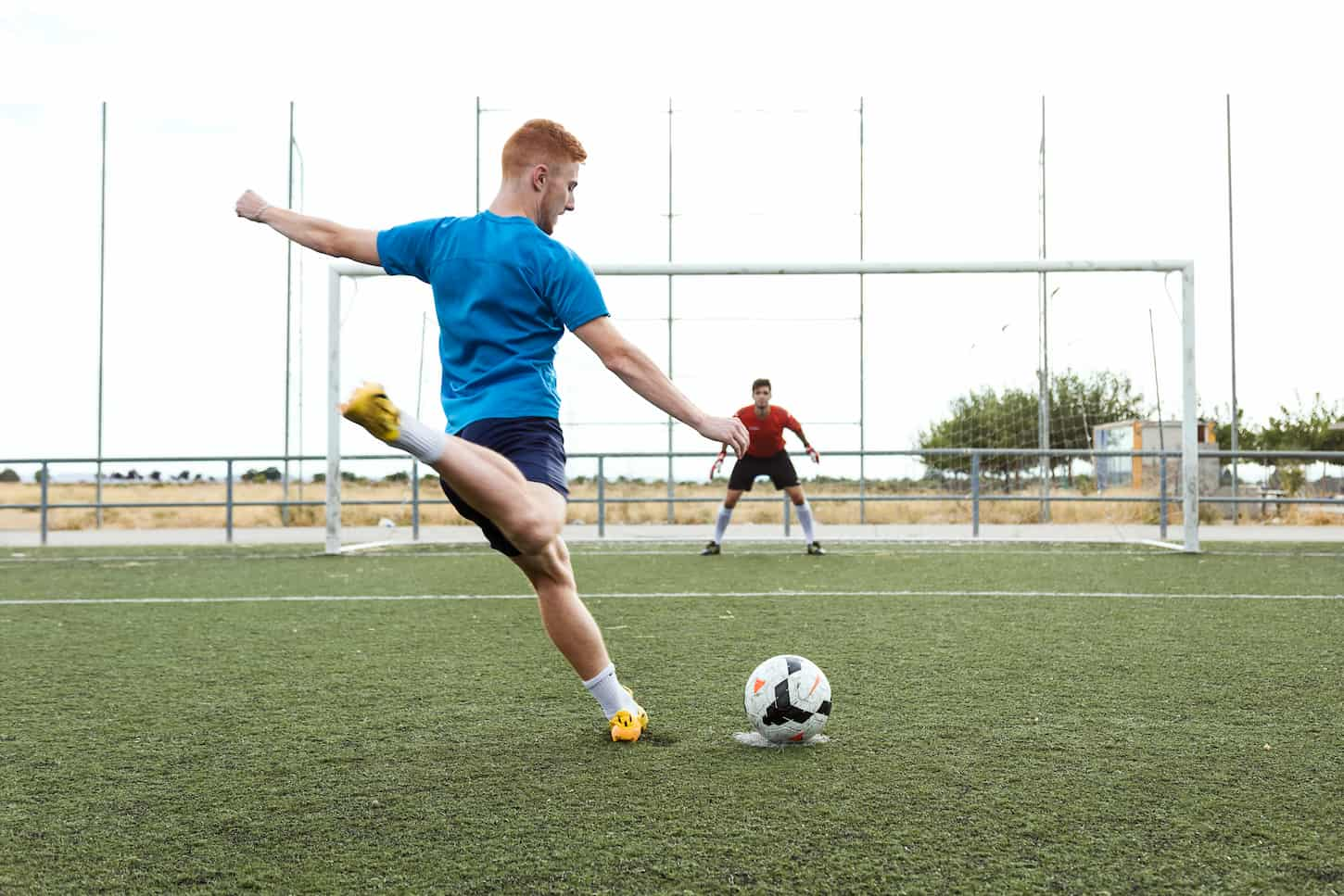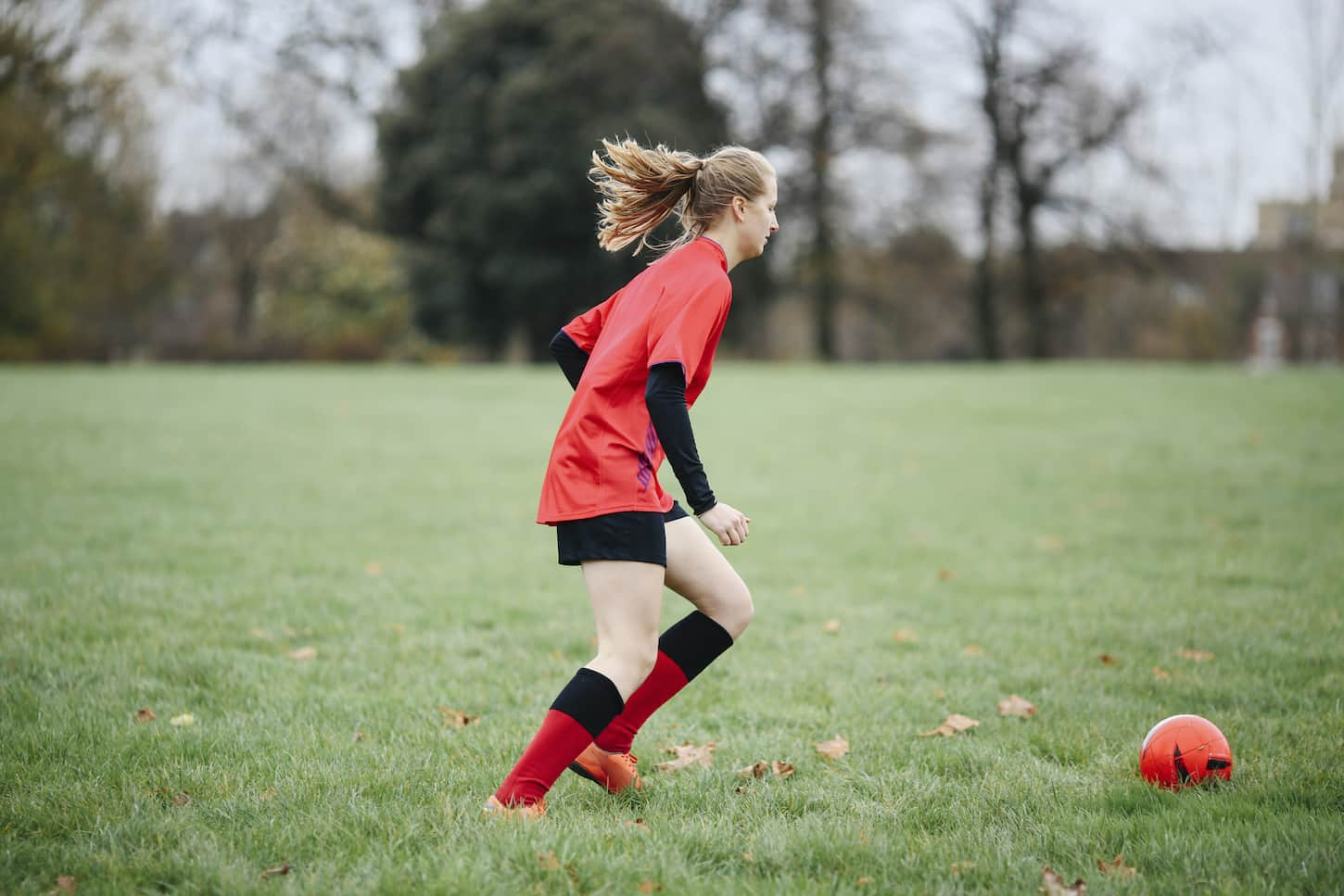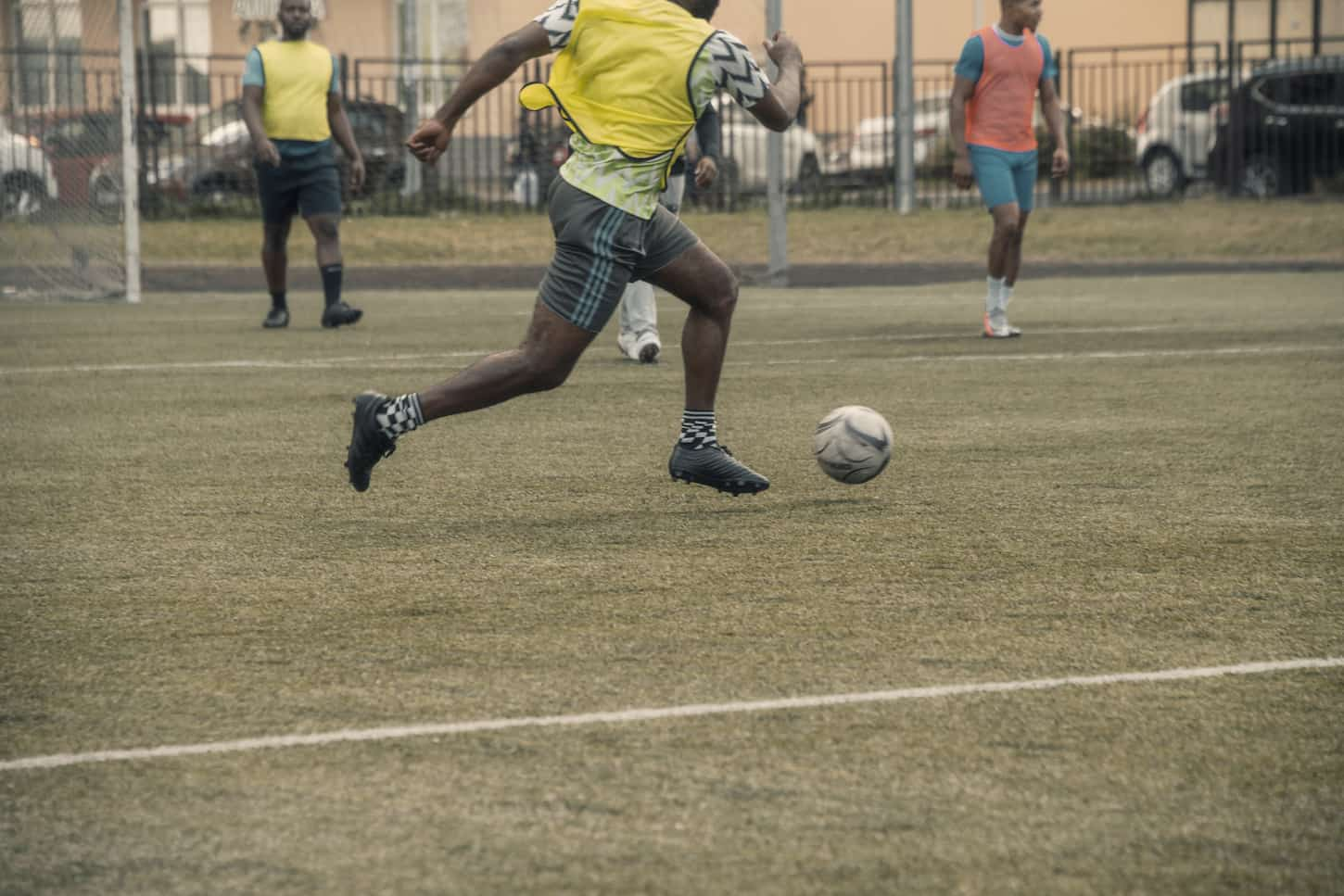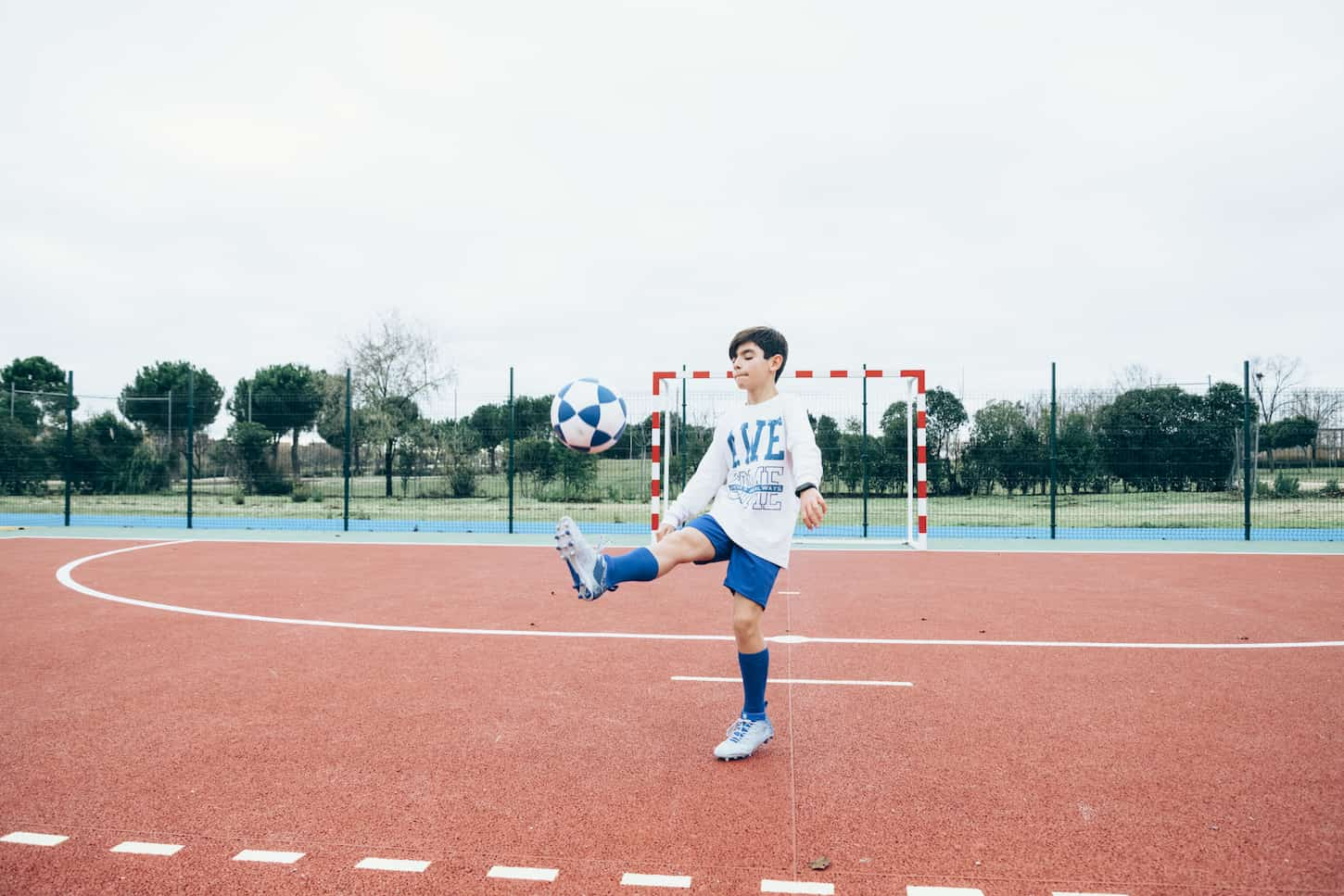The sport of soccer is growing quickly in popularity across the U.S. The USA women’s football team is currently ranked the top team in the world. We can learn many skills and techniques as players that will improve our game. One of the most respected skills is curving the soccer ball.
To curve a soccer ball, the player must put a side spin on the ball. They can do this by hitting the lower edge of the ball with the side of their foot. The kick should move upwards as they strike, creating a spin that will curve the ball.
Learning to curve a soccer ball will give us an advantage over the other team. As the path of a curved ball is not predictable, it will make it hard for defenders and goalkeepers to intercept and increase the chance of scoring.
We are here to enlighten you on how it works and how to do it yourself. If you’re ready to take your soccer skills to the next level, then read on for more information.

How Do Soccer Players Curve the Ball?
Soccer players curve the ball by kicking it at an angle. This spins the ball, and as the spinning ball interacts with the airflow, it begins curving through the air, pushing the ball in another direction.
To get the ball to curve to the left, the player needs to spin it anti-clockwise. To get the ball to curve to the right, it must rotate clockwise.
It can be hard to understand how a soccer ball can curve through the air; it seems like it defies physics. Really, though, it’s stacking several physics concepts on top of each other to get an amazing reaction.
Curving the ball is a popular technique when shooting a goal. It’s one of the most common skills when taking a free kick. A free kick is rewarded when the opposing team breaks the rules; if a free kick is near the goal area, this can be a great opportunity to score.
In these circumstances, the opposing team will make a human “wall” to deter the shooting player. Curling a soccer ball in these circumstances will help the team score a goal by getting it around the wall.
While curving a soccer ball is common in games, this doesn’t mean it’s easy. It requires consistent practice to curve a ball when it counts.

How Do I Make My Soccer Ball Curve More?
Players can make a soccer ball curve by learning the correct technique and spending plenty of time practicing. It is good to record ourselves so we can perfect our techniques or have someone watch us and give us tips on improving.
Below, we’ve broken down a step-by-step guide on how to curve a football. These steps are based on learning how to curve the ball correctly. It’s possible to learn in an open space but have a reference point to help track the curve of the ball.
Place the ball
The ground on football pitches can vary, and it’s ideal to find a spot on the pitch where the grass is slightly higher. This will lift the ball, making it easier to contact the bottom of the ball.
See where to kick the soccer ball
Knowing where we want our feet to contact the ball is important. Aim for the lower edge of the ball. Imagine a line around the middle of the ball, and then kick below it.
Spot where you want the soccer ball to go
Look at the goal and pick the point where the ball should go. Imagining the path the football will take before we hit it will help the shot to stay on target.
When shooting at the goal, aim more centrally and consider the curve. This means that if we want to hit the top left corner, our aim should be slightly to the right to compensate for the curve.
Know the contact point on your foot
When kicking the ball, use the area between the laces and the inside of the foot. Aim for the area just behind the big toe to the foot’s arch.
Run up
To effectively curve the ball, players will want to plan a run-up. The distance of the run-up depends on how far we need to kick the ball and how much power our legs produce. The most important thing is to run up at an angle; this will help us curve the ball.
Strike the ball
Kick the ball allowing the foot to follow upwards. The low-to-high movement will help create the spin. Locking the ankle and having the toes pointed upwards will help to create a spin.
Sweep your hips
Swinging our hips around will help create the spinning motion. Think of the hip moving in a semi-circle. Leaning the torso forward a little bit will help to prevent the ball from going too high.
Learning to curve a soccer ball involves more than just the movement of striking the ball. It’s also important to visualize the ball’s path and contact points. Make sure to clear your mind so you can focus; taking a deep breath can settle you into the moment.
Another element that can increase success in learning to curve a ball is making sure to warm up properly before practicing the skill. Warming up the body prevents injury and improves mobility, which will be required when attempting this kick.
Also, we should consider the equipment we’re using; having the right equipment, such as soccer cleats and a correctly inflated soccer ball, will help us learn this technique more effectively.
The final element to learning any new skill is practicing consistently and regularly. If we don’t attend regular soccer practice, we should schedule a time to work on curving the ball.
Thirty minutes a day can lead to massive improvement over a few weeks. If we cannot practice every day, then we can aim for at least three times a week, and we’ll notice the progress in no time.
How Do You Curve a Ball? For Beginners
Curving a ball can seem difficult and overwhelming for someone new to the sport. The best way to learn how to curve a ball as a beginner is to break down the technique into smaller parts. Use additional equipment to help you learn. Review all efforts and seek help to improve.
When we talk about breaking down the technique, this means practicing steps without hitting the ball. A good practice step we can break down is swinging our hips. Simply practice the movement of kicking the ball and swinging the hips in a semi-circle.
We can do this without touching the ball. By practicing any movement, we create muscle memory. Because of our muscle memory, our body will instinctively know what to do when we kick the ball.
Making adjustments is important, too. The above steps are a guideline to help us learn to curve the ball. If we’re struggling, then we can make adjustments. While the key principles remain the same, each soccer player is different.
The distance and angle of a run-up can vary from player to player. If we’re struggling to curve the ball but are unsure why it’s a good idea to record ourselves and review the footage. Then, we can use the steps as a checklist to identify where we can improve.
In addition to making a recording, ask other people for advice. Everyone was a beginner once, and if we know someone excellent at curving a soccer ball or have a coach, we can ask them to give us some pointers. Sometimes an outside perspective can help us improve our skills.
If someone is training alone and they don’t have anyone to help them, they can try searching the internet for tutorial videos. There are plenty available, and many discuss different techniques to try.

How Do You Curve a Soccer Ball Like Professional Players?
Learning to curve a soccer ball like a professional player requires extensive practice and focus. The new player also needs to spend a lot of time studying how professionals curve the ball. Fortunately, there are plenty of compilation videos online to pick up any secret tips.
The main difference between professional players and how they curve a soccer ball is in their style. Variations between the distance of run-up, angle of run-up, contact point, and follow-through all contribute to style.
Focus on making small adjustments to the technique to suit your playing style. Like professionals, you will play the best football when you’re confident and comfortable.
How To Curve a Soccer Ball in a Corner Kick
The movements remain the same to curve a soccer ball in a corner kick, but we will want to focus on aiming the ball for the teammates to receive. Once we get confident at curving the ball, we may even be able to score from the corner.
We will take a corner kick from the corner of the pitch. A corner kick is given when the soccer ball passes the goal line outside the goal, and the last player to touch it is a defending team member.
Corner kicks are a great opportunity to score, especially if players know how to curve the soccer ball.
When it comes to curving a soccer ball for a corner kick, the principles are the same. The main difference is likely to be the amount of power we use. Usually, the distance from the corner to the goal will be longer than when curving a free kick.
We’ll also need to focus on our aim as we don’t want the ball to curve too soon, hitting the outside of the net or too far away from the goal.
The main decision we will need to make when curving a corner kick is which direction to curve the ball; below are the two main curved kicks.
Inswinger
An inswinger corner kick is where the player curves the ball toward the goal. This kick aims to curve the ball into the goal at a sharp angle.
There will be a goalpost and other players obstructing the goalkeeper’s view, so when executed correctly and on target, this type of corner kick can be challenging to defend.
Curving the ball as close to the goal as possible also increases the chances that a teammate can tap the ball into the goal, as the goalkeeper will have less time to react.
When kicking an inswinger corner kick, the player needs to aim for the closest football post or just in front of the close point of the goal entrance.
Outswinger
An outswinger corner kick is where the player curves the ball away from the goal into their waiting teammates. This kick aims to connect with the teammates who will shoot the goal.
As the penalty box is often full of players during a corner kick, it can be difficult for the goalkeeper to predict which direction a shot at the goal may come from. It’s important to aim toward one of our available teammates, as we don’t want the ball to be intercepted.
When kicking an outswinger corner kick, the player needs to aim between five yards from the edge of the box to the penalty spot. As they kick the ball, they should turn their body toward where they want it to land.

Key Takeaways and Next Steps
We’ve laid out all the know-how on curving a soccer ball. It’s a great skill to have if you want to improve your playing ability, and with plenty of practice, it can help you put your team at the top of the league.
There are many applications for curving a football, but the main advantage of this skill is the ability to increase the number of goals you score. The world’s most famous soccer players, from Messi to Beckham, all have a remarkable ability to curve a football.
There’s no pressure on you to reach those levels, but it’s always fun to learn a new skill and feel confident in playing your favorite sport.
We hope you have enjoyed reading about a new trick to use while playing soccer. Here are some more soccer articles that are packed with information:
- Can A Soccer Goalie Bounce The Ball? (Rules Clarified)
- Can Soccer Goalies Wear Sunglasses? Guidelines For Protective Gear
- Is it Safe to Play Soccer in The Rain? 7 Practical Techniques
They’re all great resources, so pick the one that appeals to you. Or, if you’d rather search for something else, we’ve many articles on the site covering soccer and various other sports. Got a question we don’t cover yet? Contact us – and we’ll get that fixed!
Resources
Learning from your own experiences is important, but learning from others is also smart. These are the sources used in this article and our research to be more informed as a family of sports nuts wannabes.
- Adidas. (n.d.). Retrieved October 18, 2022, from https://www.adidas.com/us/blog/865757-how-to-curve-a-soccer-ball
- AllAttack. (2019, August 17). How to CURVE a BALL | Take AMAZING Free kicks! YouTube. Retrieved October 18, 2022, from https://www.youtube.com/watch?v=onL4ObTUr_w
- Physics Girl. (2014, July 1). The Physics Behind a Curveball – The Magnus Effect. YouTube. Retrieved October 18, 2022, from https://www.youtube.com/watch?v=YIPO3W081Hw
